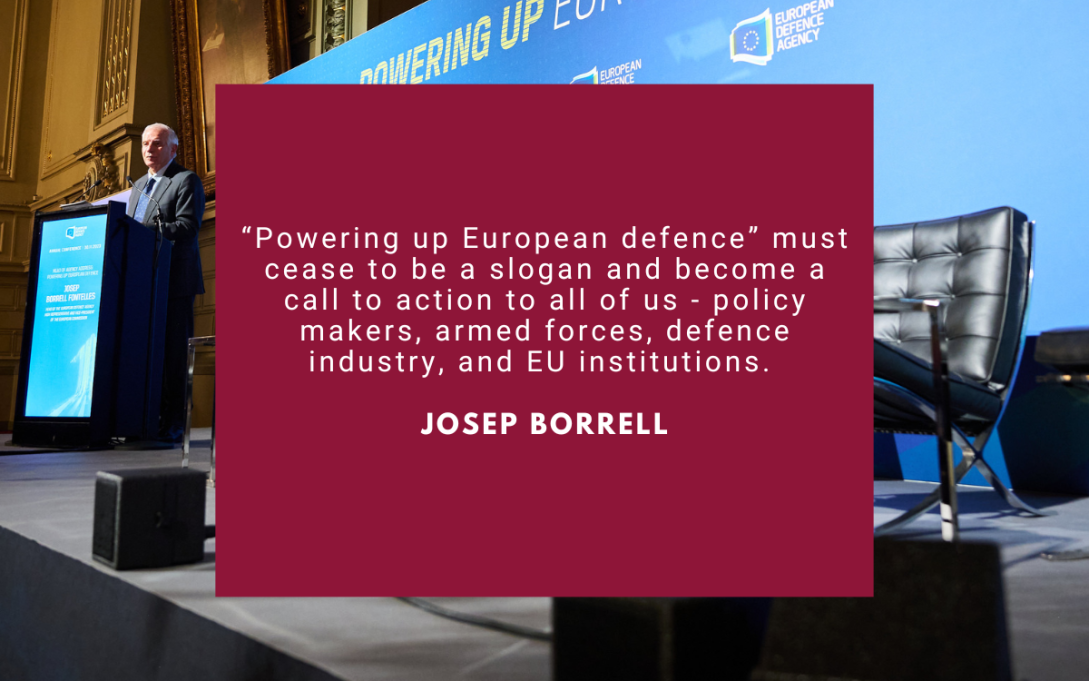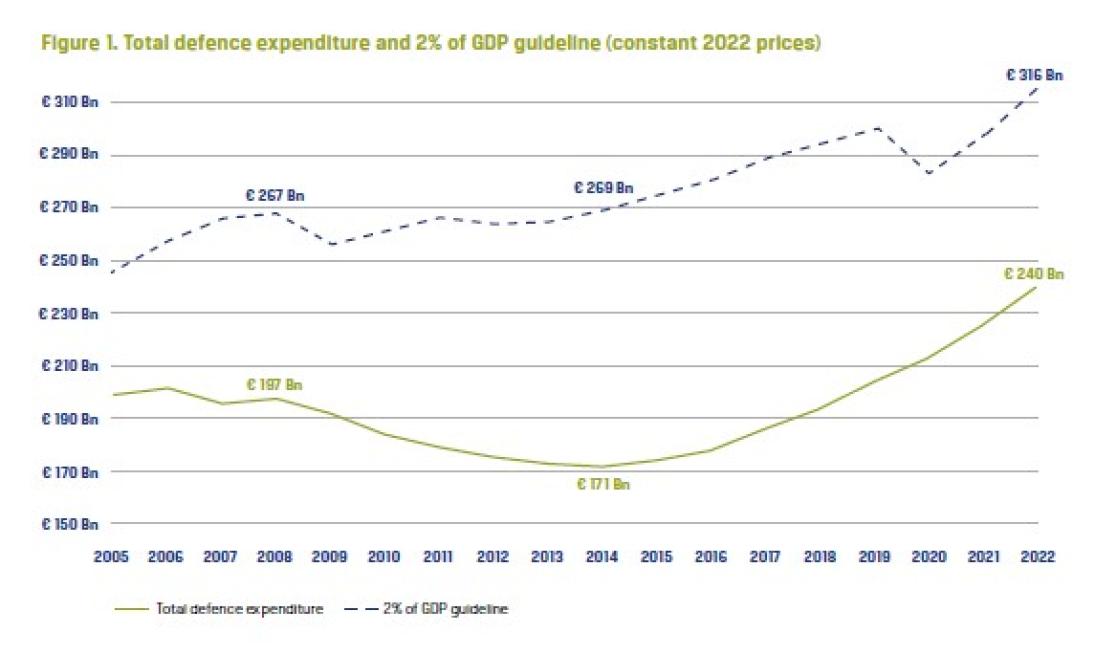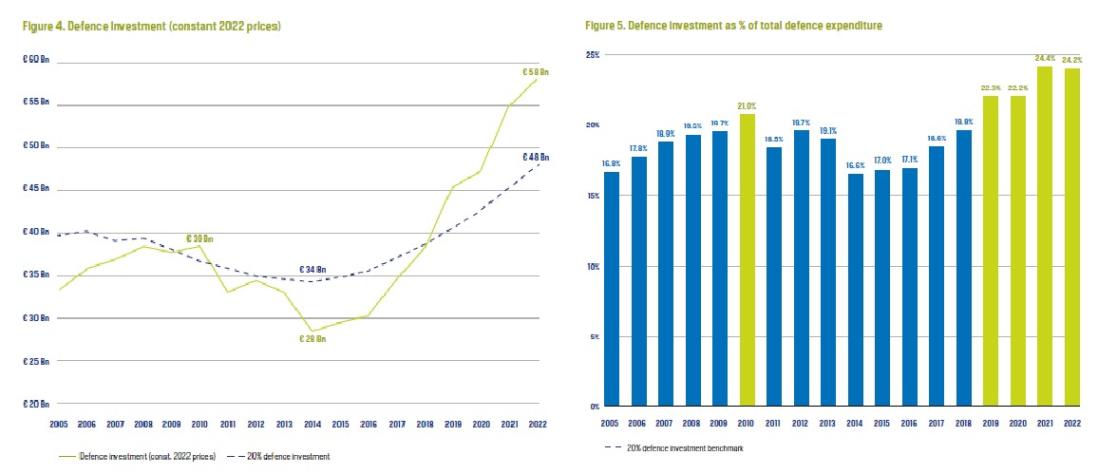Powering up European defence

In his opening speech, President Michel recalled the famous Schuman word, “Europe will not be made all at once, but it will be made”, to introduce the work we have to do - “making our security and defence union”. And President Von der Leyen recalled why our dangerous geopolitical environment implies that Europe must assume its full “strategic responsibility”, in Ukraine but also elsewhere.
Debates around defence are as old as the European project
Debates around defence are indeed as old as the European project itself. The Coal and Steel community at the very start of the European integration process had itself a strong defence industry component. In 1950, just months after the Schuman Plan, our predecessors had also the project to build a European Defence Community. A history, in which defence cooperation could have been the sibling of market integration, would have been possible. However, with the rejection of the European Defence Community by the French Parliament in 1954, we chose a different path back then.
Today, the EU finds itself in a geostrategic context that, unfortunately, makes “powering up European defence”, the theme of this year’s EDA annual conference, an urgent imperative. And we have a lot of catching up to do. Two years ago, when presenting the Strategic Compass, I said that “Europe is in danger”. It was before Russia’s war of aggression against Ukraine, before the major security crisis in the Sahel and before the war that is flaring up again in the Middle East.
With the Strategic Compass we called for ‘a leap forward’ in European defence. It is obviously time to jump now.
Since then, the danger for Europe has only grown. Russia’s war against Ukraine has reminded us how critical traditional military capabilities like tanks, artillery or ammunition remain; but also how much hybrid threats on space, cyber, critical infrastructures, information manipulation or security of supply, have become real. With the Strategic Compass we called for ‘a leap forward’ in European defence. It is obviously time to jump now.
Moving to a sustained defence effort
The EU reaction to Russia’s war of aggression was unprecedented on many levels and particularly on the military one. I remember very well on the first days of January 2022, one month before the Russian war of aggression started, I visited the Donbass and I had a meeting with Denys Smyhal, the Prime Minister of Ukraine. He asked me: “They will invade us, and when this happens, will you support us? Are you going to provide us with the arms that we will need in order to defend ourselves?” I could not say back then “yes, for sure, we will”. Military aid to a country at war was still a taboo and I was not certain that we could do what in the end we did.
This taboo has indeed been broken and the EU has for the first time, militarily supported a country at war, including with lethal equipment. So far, the EU and its Member States have mobilised over € 27 billion of military support. More than 34 000 Ukrainian soldiers has been trained nearly everywhere on EU’s soil.
We have used innovative tools with the European Peace Facility. We used also innovative approaches with the three-track ammunition initiative. Lead countries and the European Defence Agency have pooled Member States’ demand in order to joint procure of ammunition. The European Defence Agency has signed 9 framework contracts, with more to be signed in coming weeks. Seven member states have already placed orders.
However, we need to step up our efforts regarding ammunition. It is crucial that member states place more orders with the defence industry as soon as possible. And we have to increase our production capacities. To accelerate this endeavour, the Commission, thanks in particular to my colleague Commissioner Breton, has put in place the new “Act in Support of Ammunition Production” (ASAP) and “European Defence Industry Reinforcement through common Procurement Act” (EDIRPA).
We have started to discuss the EU’s contribution to security commitments to Ukraine and a dedicated financial envelope within the European Peace Facility for long-term military support to the country. In this context, stepping up joint procurement efforts and ramping up industrial production capacity acquire even greater strategic importance.
The need to address our weaknesses
Our mobilisation to support Ukraine has been impressive. However, this war has also exposed the negative consequences of our lack of defence investment in previous decades. It has reminded us how important NATO remains to our collective defence – but also what needs to be done to strengthen the European pillar of NATO, as our American friends have been asking for. All the more so, considering the level of uncertainty regarding the future of US foreign and security policy. We need transformational and sustained efforts to bring a change of mind-set in EU defence.
Until 2014, Europe has gone through a silent process of disarmament. Crimea’s invasion was the first wake-up call and since then we have undertaken the biggest European rearmament effort since the 1950s.
The new EU Defence data report published by EDA illustrates where we stand and the challenges ahead. In 2022, defence expenditure of the 27 Member States increased for the eighth year in a row, reaching €240 billion, in real terms, + 6% compared to 2021, showing a real effort by member states to sustain the trend. Compared to the historic low of 2014, defence expenditure has increased by €69 billion, or 40% in real terms. Until 2014, Europe has indeed gone through a silent process of disarmament. Crimea’s invasion was the first wake-up call and since then we have undertaken the biggest European rearmament effort since the 1950s.

Investments in new defence capabilities reached €58 billion in 2022 - 24% of total defence expenditure. For the 4th year in a row, we are above the 20% benchmark set for defence investment. However, the total defence expenditure still stagnate around 1.5% of the Gross Domestic Product. To reach the 2 % NATO target, Member States would need to spend additional €76 billion.

Other global actors are all allocating a much bigger share of their resources to defence. The US spent on average 3.5% GDP in the past three years, two points more of their GDP than us. Russia increased its defence expenditure from 3.6% GDP before the war to 4.3% in 2022. And for 2024, it has just approved an increase by 70% of its defence budget compared to 2023.
I have said many times since the beginning of my mandate that we need to “invest better, together” in our defence. It has to stop to be a slogan to become a reality!
The EU still lack critical defence capabilities and we still need to invest more on defence. I know that it is very difficult to achieve at a time when the economy is not flourishing but we urgently need to do so. And, most importantly, we need to do it together in a closely coordinated way to fill gaps, avoid duplication and strengthen industrial capacities. I have said many times since the beginning of my mandate that we need to “invest better, together”. It has to stop to be a slogan to become a reality!
How to invest better together?
We have the frameworks needed with the Coordinated Annual Review on Defence, the Permanent Structured Cooperation and Commission’s instruments to support such efforts, like the European Defence Fund. The 68 projects currently running under PESCO show that cooperation can work but we should be more ambitious. PESCO projects have to touch more the core of the defence capabilities. Why could we not develop, for instance, a next generation of warships through PESCO? The PESCO strategic review we have just launched will be an opportunity to think bigger.
To succeed in developing capabilities together, the starting point is to identify common priorities. The industry has to build the production capacities, but it is up to our armed forces to define what they need. This is EDA’s core job – through the Capability Development Plan. A few weeks ago, the 27 ministers of Defence agreed on a new set of priorities across the five strategic domains - land, air, maritime, cyber and space – as well as across the strategic enablers and force multipliers.
These priorities reflect the lessons learned from Ukraine, but also the needs for the EU Rapid Deployment Capacity, one of the flagship projects of the Strategic Compass. In some situations, we would need to be able to deploy quickly forces, like in Kabul in August 2021 or more recently in Sudan. In such cases, going together, would multiply our capacities and reduce risks and costs. In October, I was in Cadiz for the first ever EU live military exercise in prefiguration for the deployability of this force as of 2025.
End of November, the new Multinational Helicopter Training Centre (MHTC) in Sintra, Portugal, has taken over the existing EDA training programmes. Thousands of helicopter crews from 16 Member States have already been prepared for multinational deployment. EDA is also supporting effective interoperability on the ground.
We also need to do more to aggregate demand and procure together. With the ammunition initiative, the EDA has proven they can do it. And they will now launch joint procurement also for CBRN and soldier equipment.
A stronger, resilient and innovative European defence industry
Another important lesson from Ukraine is that our defence industry is not strong and resilient enough. EDIRPA and ASAP are immediate responses. But we need to look at the longer term. This is what we intend to do with the upcoming European Defence Industrial Strategy. In her keynote speech, President von der Leyen has outlined the main building blocks of the future strategy.
Defence industry is an area where close cooperation is essential between the intergovernmental bodies responsible for EU defence policy, such as the EDA, and the Commission services in charge of the European budget.
My team and I are working closely with Commissioner Breton and Commission services on this. Defence industry is an area where close cooperation is essential between the intergovernmental bodies responsible for EU defence policy, such as the EDA, and the Commission services in charge of the European budget.
There will not be any European strategic autonomy or strategic responsibility without a strong European defence industry. But today, we have a quite fragmented one in Europe and more than two third of the military equipment bought by European army are coming from outside Europe.
The challenge of access to finance for the EU defence industry
The challenge of access to public and private finance for the EU’s industrial defence sector also needs to be addressed urgently as stated by the EU Defence Ministers during our last EDA ministerial board meeting.
I was very surprised when one important European banker told me that the risk committee of his bank would advise not to finance defence projects. Our society needs to understand that we have to invest public but also private money in defence. Defence expenditure is not a waste of money but an existential requirement to face the many challenges of our world. The defence industry can also support the economy, creating jobs and helping boost innovation.
Looking at the longer term, defence innovation is indeed critical. Here, however, the latest EDA data show a rather negative trend: the defence R&T (Research & Technology) expenditure is decreasing in Europe. We urgently need to reverse this trend if we want to be able to develop the state-of-the art defence capabilities Europe will require in the future. The EDA’s Hub for Defence Innovation can play a role in this context. In this area, we work also closely with the Commission on the development of critical dual-use technologies with the support of the European Defence Fund.

Towards a strategic European defence culture
EU defence has come a long way during the last years, but the degradation of our geostrategic environment obliges us to do much more, in a much more closely coordinated way and with a much greater sense of urgency.
The degradation of our geostrategic environment obliges us to do much more for EU defence, in a much more closely coordinated way and with a much greater sense of urgency.
We already have the frameworks and instruments to do so and in particular a dedicated Agency – the European Defence Agency – to help set priorities, foster defence cooperation and spearhead defence innovation. Next year we will celebrate EDA’s 20th anniversary. It will be a timely opportunity to give the Agency a boost towards a higher level of ambition.
In an age of power politics, “Powering up European defence” must cease to be a slogan and become a call to action to all of us - policy makers, armed forces, defence industry, and EU institutions. The transformation sparked by Russia’s war against Ukraine, must be turned into a sustained and strategic European defence culture.
MORE FROM THE BLOG

"Une fenêtre sur le monde" - Blog du HR/VP Josep Borrell
Blog de Josep Borrell sur ses activités et la politique étrangère européenne. Vous pouvez également y trouver des interviews, des articles d'opinion, une sélection de discours et de vidéos.
